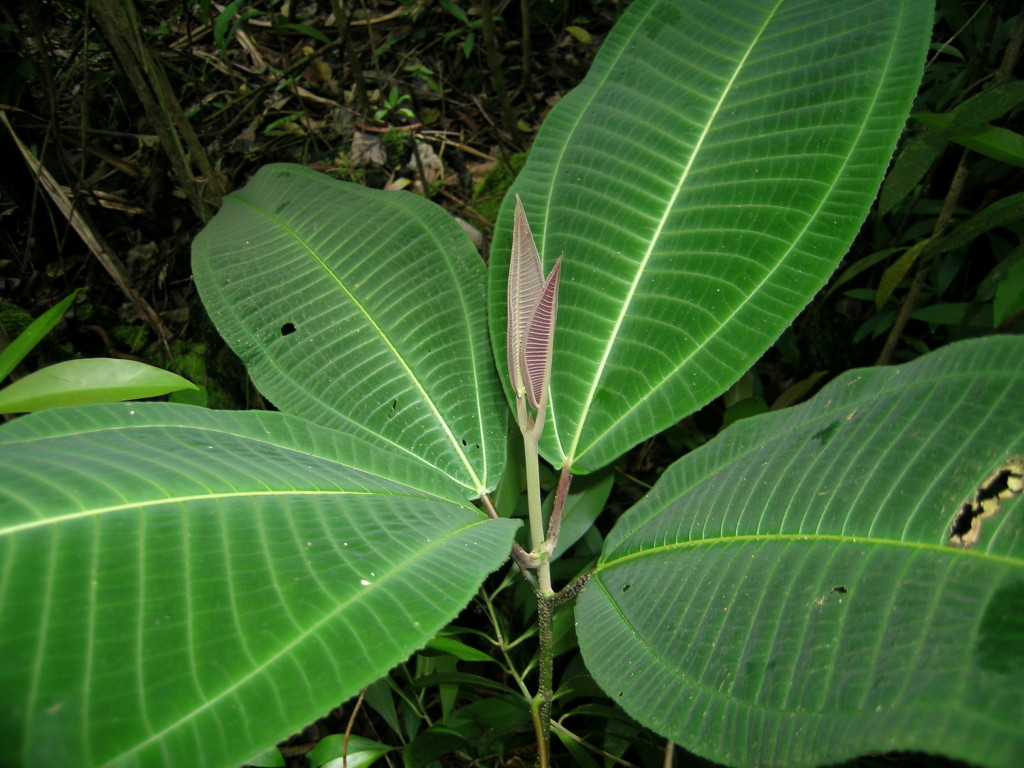Invasive Species » Unit 2: Invasive Species Impacts: Why Care? » Activity 2: Raindrops and Watersheds: Size Matters
Materials & Setup
Class Period One
For each student
- Student Pages “Water Droplet Lab Worksheet” (p. 16)
For each group of 3-5 students
- A sampling of large and small leaves picked from around the school grounds or brought from home. For large leaves, the bigger the better (example: ginger, ti, or banana leaves). For small leaves, leaves averaging three inches long are ideal.
- Flour (2-3 cups)
- Plate
- Spray bottle
- Ruler
- Mesh metal strainer, such as an extra large tea strainer
Note: Use the information in the Teacher Background “Raindrops and Hydrology” (p. 15) to familiarize yourself with the miconia hydrology research. Also, moderating the speed and number of water droplets falling from the leaf can be tricky. Do the experiment once in front of the class to demonstrate how to allow only one droplet to fall into the flour at a time.
Class Period Two
- A sampling of large and small leaves picked from around the school grounds or brought from home
- Twigs, small rocks, moss and other leaf litter
- Flour, diatomaceous earth, or soil
- Flat tray or baking sheet
- Spray bottle
Instructions
Class Period One
1) For context about miconia and its effects on native Hawaiian forests, show the Miconia Threatens Maui video included in this curriculum. (Also available on the web at this YouTube link.)
2) Tell students that they will be replicating a scientific study that identifies one way that miconia alters the ecosystem.
3) Break the class into groups of 3-5 students. Tell them they will be simulating rain falling from large and small leaves in the forest, and comparing the size of drops.
4) Have each group pour a layer of flour in the plate (roughly 1-2 inches deep) and level it off with the ruler.
5) Spray a leaf with fifteen squirts of water from a spray bottle. Do this away from the flour.
6) Quickly tilt the tip of the leaf over the flour and allow 4-5 raindrops to roll off the tip of the leaf and into the flour. Make sure each droplet has its own clear space on the flour. Droplets will join together on the leaf, but try not to let two droplets fall in the same spot. After five individual droplets fall onto the flour, remove the leaf.
7) Your flour should now be dotted with individual rain droplets. Flour will congeal around each rain droplet. Carefully separate each rain droplet.
8) Sift the droplets from the plate by pouring the flour through a strainer. (You may want to gently roll each droplet into a ball.) Measure the diameter of each droplet in millimeters. If droplets are oblong shapes, measure both sides and record the average size.
9) Have students repeat instructions 2-6 twice, using large leaves and small leaves. They will record the measurements for ten drops from a large leaf and ten drops from a small leaf on the Student Page “Water Droplet Lab Worksheet.”
10) Have students compare the sizes of the droplets that resulted from the larger leaves to those from the smaller leaves.
11) Engage students in discussion: were there significant differences in the size of raindrops falling from the different leaves? How might larger or smaller raindrops make a difference in the functions of the rain forest? Did the shape of the leaves make a difference? Use Teacher Background “Raindrops and Hydrology” to explain context of experiment.
Class Period Two
1) Construct a simulated “healthy forest understory,” using flour, diatomaceous earth or actual soil, small rocks, sticks, moss, and leaves. Arrange the components on a flat tray. Elevate one side of your forest to represent the gentle rise in elevation typical of the mountain rainforests of Maui. Place a bin on the downhill side of your tray to collect debris.
2) Have each group of students select a nozzle setting on the sprayer, ranging from mist to stream.
3) Spray for two minutes and record the volume of erosional debris that has washed from the tray.
4) Construct a “miconia understory,” using only flour or soil and several large sticks. (The sticks represent miconia’s shallow roots.) Omit mosses and leaves. Repeat the exercise above, record measurements, and share results in class discussion.
5) Discuss the results as a class. What might this mean for Hawaiian forests that have been invaded by miconia?
Journal Ideas
- What were your expectations prior to conducting the lab? Did you think the leaf size would affect the water droplet size? Why or why not?
- How could soil health in Hawaiian forests affect coral reefs? Agriculture? Public safety?
Assessment Tools
- Lab results
- Participation in class discussion
- Journal entries
Media Resources
- Hydrology Slideshow
- Show “Hydrology” powerpoint and discuss. (Included in this curriculum.)
- Read the Robert Hobdy’s essay, The Many Faces of Koa
- Have students design a lab to evaluate the variance between slender, medium, and thick koa phyllodes as described in Hobdy’s essay.

